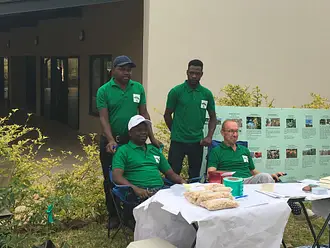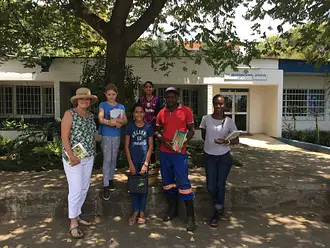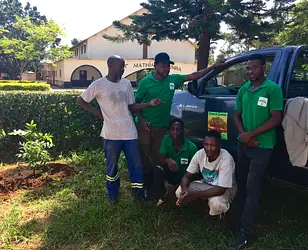Trees for Zambia was started by Adam and Clare Pope in the 1990’s.Adam Pope has spent all his life in Zambia. He shares with his family a deep love of the African bush, learning to identify the flora of Zambia from an early age. Adam started collecting seeds on his bush expeditions, stuffing seeds in pockets, then planting them and surprised when they germinated and flourished.
The hobby grew from a rather hit and miss affair to a tree nursery with over 100 different indigenous species and probably over eight thousand seedlings and several hundred trees of all sizes. Clare helps with the day to day management of the nursery and is interested in the use of indigenous trees in garden and landscape design and has used indigenous trees in several landscaping works, amongst others: Baobab college, International School of Lusaka, Thabo Mbeki Abacus House, Eureka Park on Kafue Road, the two campuses of Japanese Tobacco Industry in Kaoma and Chisamba.
Sam Susu, Trees for Zambia manager, started working with us about 20 years ago. His knowledge of trees and how to grow them is arguably the best in Zambia.
Lovemore Mupando has worked for Trees for Zambia since a very young age. He is fast becoming an expert.

We now have nearly 10,000 tree and shrub seedlings of over 100 different species, ready for sale. All the trees are grown from seed collected in Zambia. Trees for Zambia is also planting an arboretum of indigenous trees and shrubs and an area of wilderness has been set aside for conservation purposes, which will be developed over the coming years.
The challenge remains to persuade the urban planners that planting indigenous trees is a good idea and that indigenous trees are a good alternative to the popular exotic trees that dominate the urban landscape.
TREES for ZAMBIA and Indigenous Trees
Trees are life. Without trees rainfall, river flows and agricultural crop production may all be diminished. Trees clean and cool the air, act as a carbon sink, and are an important part in controlling global warming and climate change. Trees protect our soils and our water sources.
The Zambian landscape is characterised by its trees – the extensive tracts of miombo woodland, the umbrella acacia, the magnificent baobab, the sprawling sycamore fig, and the majestic red mahogany. Indigenous trees that were planted in several Zambian cities 50 or more years ago give streets character, shade and beauty. Indigenous trees that have been planted more recently at offices, shopping centres, memorial parks and along streets benefit us now and will continue to do so over the next 50 years.
Trees for Zambia grows indigenous trees and plants and provides information to interested people about their beauty and usefulness.
Trees for Zambia has five areas of interest and activity:
Raising awareness of uses of indigenous trees through publications and social media.
Conservation of indigenous trees – some of which are highly endangered species.
Tree planting projects in public places with local groups and NGOs..
The sale of indigenous trees and landscaping with indigenous plants.
Threatened and Endangered Plant Species
Wherever practicable Trees for Zambia seeks out and plants endangered species that have been decimated by logging. These include the familiar Pterocarpus chrysothrix(Mukula), Pterocarpus angolensis (Mukwa) and Khaya anthotheca, (Red Mahogany). However, unregulated logging is proceeding at such a rate in Zambia and the region that other hardwood species now urgently require conservation support, particularly: Baikiaea plurijuga (Zambezi Teak), Guibourtia coleosperma (Rosewood) and Entandrophragmacaudatum (Mululu), but the list is growing almost daily with species such as Sterculia quinqiloba and several Brachystegia species, together the less familiar Cassipourea fanshawei, Embelia upembensis, Hallea stipulosa and Encephalartos schmitzii all vulnerable species. Regrettably, many of the commercially-targeted hardwoods are hard to cultivate in nurseries, slow growing and require improved woodland management and fire control for their survival.
Conservation Support
Trees for Zambia also supports environmental groups such as the Wildlife and Environmental Conservation Society’s Chongololo and Chipembele Clubs, and schools, by giving talks and managing tree planting projects, such as Leave Roots in Zambia (Lusaka International Community School and Wildlife Education and Conservation Society of Zambia), and the Baobab College and International School tree planting days.
The Urban Landscape
We also offer advice on appropriate planting schemes for urban areas, schools, shopping centres, businesses, golf courses, and domestic spaces.
What started as a hobby has now become a passion that we think many people share. Trees for Zambia will do everything to ensure that information is available to our supporters and hope to continue in our small way to conserve trees and educate.







Comments